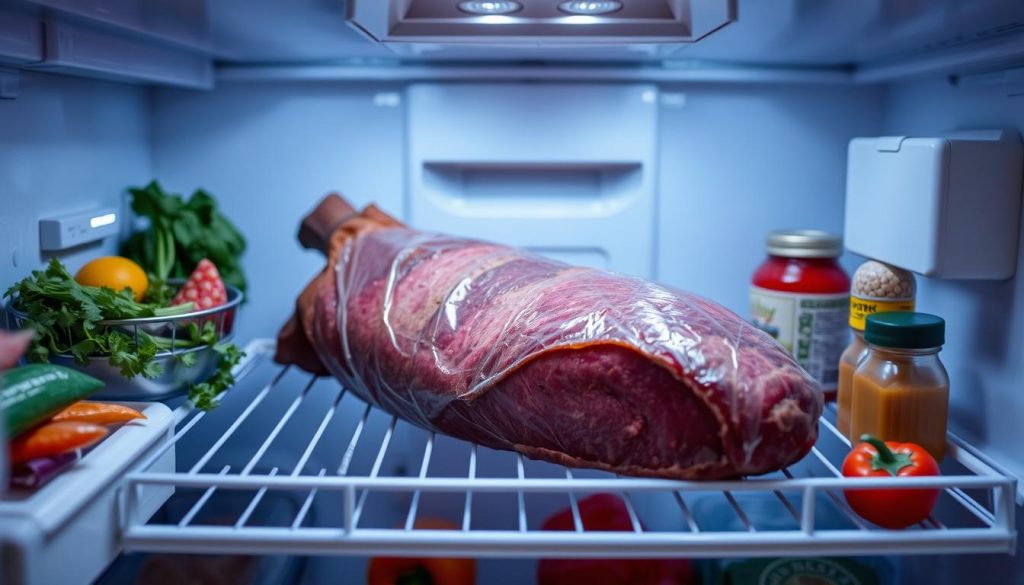Enjoying brisket’s rich flavors is great, but knowing how to store it is just as key. We’ve got tips to keep your brisket fresh and safe in the fridge. Our goal is to make sure your brisket stays delicious and safe for a long time.
Storing brisket right is not just about keeping its taste and texture. It’s also about keeping you healthy. Keep your fridge at 40°F (4°C) or colder to stop bacteria. Also, choose fresh brisket and handle it carefully before storing.
If you’ve cooked a brisket, eat it within 3–4 days to avoid spoilage. Freezing it? It stays best for 6 months, but it’s safe for up to 12 months if stored properly.
Key Takeaways
- Always maintain a refrigerator temperature below 40°F (4°C) for brisket storage.
- Fresh brisket’s fridge lifespan is typically 3–5 days, while its freezer lifespan extends to 12 months.
- Proper packaging, such as vacuum-sealing, can significantly extend brisket’s fridge shelf life.
- Leftover cooked brisket should be enjoyed within 3–4 days when refrigerated.
- Thawing brisket safely requires patience; use the refrigerator thawing method for best results.
- Reinvent your brisket leftovers with creative recipes that maintain quality and taste.
The Importance of Properly Storing Brisket
Knowing how to store brisket is key to keeping it fresh and safe. We’ll look at the main points for a longer shelf life, less bacterial growth, and keeping meat fresh and safe.
The Role of Temperature Control
Keeping brisket below 40°F is vital to avoid foodborne illnesses. This stops bacteria from growing fast at warmer temperatures. Cold storage prevents spoilage and keeps the brisket good to eat longer.
Impact of Humidity Levels
Humidity in your fridge affects brisket’s life. Too little makes it dry, losing flavor and texture. Too much encourages bacteria, making it unsafe. The right humidity keeps meat juicy and safe.
Significance of Adequate Packaging
Good packaging stops illnesses by keeping out contaminants. Vacuum sealing creates a tight space, reducing bacteria and pollutants. It keeps meat fresh and extends its life.
Handling and Freshness Factors
Handling brisket right is key to less bacterial growth. Avoid touching it with dirty surfaces or tools. Also, buying fresh meat makes a big difference. It lasts longer and tastes better.
Here’s a table summarizing optimal brisket storage details:
| Storage Condition | Impact |
|---|---|
| Temperature Below 40°F | Reduces bacterial growth, preventing foodborne illnesses. |
| Humidity Control | Prevents drying out and excessive moisture. |
| Vacuum Sealing | Enhances brisket shelf life and freshness. |
| Proper Handling | Minimizes contamination risks. |
In summary, focusing on temperature, humidity, packaging, and handling helps a lot. It extends brisket’s shelf life, reduces bacteria, and keeps it safe. This ensures a high-quality, safe brisket for our meals.
Guidelines for Refrigerating Fresh Brisket
Keeping brisket fresh and safe starts with good refrigeration practices. We’ll show you how to store brisket right. This helps keep it fresh and safe to eat.
Optimal Refrigeration Temperatures
Keeping brisket at the right temperature is key. Always keep it at or below 40°F. This stops bacteria from growing, keeping your meat safe and fresh.
For more tips on storing brisket, check out how long does brisket last in the fridge.
Shelf Placement and Cross-Contamination Prevention
Preventing cross-contamination is very important. Store brisket on the bottom shelf. This stops juices with bacteria from getting on other foods.
Proper placement is a simple way to keep food safe.
Labeling and Tracking Freshness
Tracking meat freshness is important. Label your brisket with the date you bought it and the sell-by date. This helps you know when to cook or freeze it.
Maximizing Brisket Freshness with Freezing
Freezing is a top choice for keeping brisket fresh and tasty for a long time. We follow strict freezing meat guidelines to freeze brisket right. This means wrapping it tightly in freezer-safe material or using a heavy-duty freezer bag to remove air.
This careful wrapping is key to preventing freezer burn and keeping the brisket in top shape.
For those planning ahead, safe thawing practices are very important. We suggest thawing brisket in the fridge. This method keeps the meat at a safe, steady temperature and thaws it slowly.
It might take about 24 hours for every 5 pounds of brisket to thaw. But it’s worth it for the meat’s quality and safety.
- Store brisket using proper guidelines to ensure up to three months of quality retention in the freezer.
- Vacuum-seal brisket to extend freezer life up to 12 months, preserving its taste and texture.
- Label brisket with the date of freezing to effectively manage long-term meat storage.
Whether it’s raw or cooked, the rules for storing brisket are the same. Proper packaging and slow thawing help keep its flavor and texture. This way, your brisket stays as delicious as the day you stored it.
By following these steps, you not only keep your brisket fresh but also help reduce waste. This is because you avoid spoilage and cut down on food waste.
How Long Does Brisket Last in the Fridge?
As food lovers and safety-conscious cooks, we all value keeping our meat fresh and safe. Brisket is no exception. Knowing how long it lasts in the fridge and when it’s safe to eat is key. It’s important to enjoy brisket without worrying about its quality or safety.
General Refrigeration Timelines for Brisket
Fresh brisket can last up to five days in the fridge if it’s stored at 35 to 40 degrees Fahrenheit. If your fridge is colder, it can last up to eight days. Cooked brisket, on the other hand, has a shorter fridge life. It can last four days without gravy and two days with gravy.
Identifying Spoilage and When to Discard
It’s vital to spot meat spoilage to avoid foodborne illnesses. Look for sour smells, slimy texture, and color changes. If the brisket smells bad or feels slimy, it’s time to throw it away. These signs mean it’s past its safe eating time.
- Sour or unpleasant odors
- Slimy texture upon touching
- Noticeable color changes
To keep brisket safe, refrigerate or freeze it within two hours of cooking. This stops harmful bacteria from growing, which can cause illness.
Meat safety is about more than just storage. It’s also about watching for spoilage signs. Always check your brisket during and after storage to make sure it’s safe to eat.

Indicators of Spoilage in Brisket
When we talk about the freshness and safety of brisket, recognizing the spoiled brisket signs is key in foodborne illness prevention. Let’s explore how to spot if a brisket has gone bad through clear indicators.
Assessing the Smell
One of the most definitive signs of bad meat is its smell. Fresh brisket should have a mild, not unpleasant smell. If you detect a sour or ammonia-like odor, it’s a clear signal that the brisket may be spoiled. This strong, distinct smell is caused by bacterial growth affecting the meat’s quality and safety.
Monitoring Color and Texture
Observing the color and texture offers further clues about the brisket’s condition. A healthy piece of brisket should have a consistent deep red color when raw. If you notice any greenish hues or an overall dull and gray appearance, these are spoiled brisket signs. Touching the brisket can also help assess its condition. Fresh brisket should be slightly moist but never slimy or sticky. A slimy texture indicates the presence of bacterial colonies, which could lead to serious health issues if consumed.
Beyond the direct signs, understanding the spoilage ecology of brisket also helps in better preserving and handling this favorite cut. Here’s a straightforward table summarizing the usual refrigerated life-span of various beef products, which includes brisket:
| Beef Product | Expected Refrigerated Lifespan |
|---|---|
| Raw steaks and roasts | 3-5 days |
| Ground beef | 1-2 days |
| Organ meats (liver, kidneys) | 1-2 days |
| Cooked beef stews and soups | 3-4 days |
| Leftover cooked beef (slices from roast/steak) | 3-4 days |
| Marinated beef | 3-5 days |
Maintaining the safety of our meals includes recognizing these signs and taking immediate action to discard suspected spoiled meat. This proactive approach not only safeguards our health from foodborne illnesses but also ensures that our culinary experiences with brisket remain delightful and safe.
Enhanced Techniques for Extending Brisket’s Shelf Life
Looking for ways to keep brisket fresh longer is smart. It helps you enjoy your meat more and saves money. By using vacuum sealing and the right packaging, we can keep brisket fresh for a long time.
The Art of Vacuum Sealing
Vacuum sealing is key to keeping brisket fresh. It removes air, stopping meat spoilage. This way, brisket stays good in the fridge for 2-3 weeks, keeping its taste and texture.
Evaluating Different Packaging Materials
Choosing the right packaging is important for brisket. Plastic wraps and aluminum foil can add a few days. But vacuum sealing is best, keeping brisket fresh for 5 days or more.
Let’s look at how different packaging methods compare for keeping brisket fresh.
| Method | Shelf Life Extension | Refrigeration Needed |
|---|---|---|
| Plastic Wrap | 1-2 days | Yes |
| Aluminum Foil | 3-4 days | Yes |
| Vacuum Sealing | 5+ days | Yes |
Using these methods helps keep brisket fresh longer. It also follows safe food handling rules. This way, we can enjoy brisket for longer, keeping it tasty and safe.
Thawing Frozen Brisket Safely
Starting with safe defrosting methods is key to your brisket’s safety and quality. We recommend slow thawing in the fridge to keep thawing temperatures for meat just right. This method keeps your brisket’s texture and flavor perfect.
Refrigerator Thawing vs. Cold Water Thawing
Refrigerator thawing is slow but safe. It takes about 2 days for a 10-pound brisket to thaw. This follows USDA guidelines for meat thawing.
Cold water thawing is faster, taking about 30 minutes per pound. You need to seal the brisket in a waterproof bag and keep it in cold water. Change the water every 30 minutes. Cook the brisket right after thawing with this method.
Here’s a quick comparison of both techniques:
| Method | Time Required | Food Safety | Post-Thaw Action |
|---|---|---|---|
| Refrigerator Thawing | 2 days for a 10-pound brisket | High (safe temperature maintained) | Can be refrigerated for a few days before cooking |
| Cold Water Thawing | 30 minutes per pound | Medium (requires vigilant water change) | Must cook immediately |
We suggest using these safe defrosting methods for your brisket’s safety and quality. These methods are backed by experts like Acabonac Farms.
Choosing the right thawing method is important for thawing temperatures for meat and food safety during meat thawing. Refrigerator thawing is the best for quality, but timing and needs can guide your choice.
Creative Ways to Utilize Leftover Brisket
Wondering what to do with that smoked brisket from last night’s barbecue? Don’t let it go to waste! With smart strategies for reheating smoked meat and innovative leftover brisket recipes, we can transform your cooked brisket into delicious new meals. Whether you’re looking to whip up a quick dinner or prepare a savory dish that impresses, here’s how you can repurpose brisket effectively while maintaining brisket moisture.
Reheating Leftovers without Compromising Quality
Reheating brisket requires care to preserve its juiciness and flavor. To ensure your brisket stays succulent, gently reheat it at a low temperature in your oven or using a microwave. Cover the brisket to trap the steam, which helps in maintaining brisket moisture. Always heat to an internal temperature of 165°F to ensure it’s warm and safe to enjoy.
Transformative Brisket Recipes
Repurposing brisket opens up a world of culinary possibilities. From Italian to Asian cuisine, the versatility of brisket invites creativity. Here’s a taste of what you can cook up:
- Brisket Tacos: Use tender brisket slices topped with Pico de gallo and diced jalapenos for a Mexican night.
- Brisket Mac ‘N Cheese: Combine brisket chunks with creamy macaroni and cheese for a hearty meal.
- Brisket Grilled Cheese: Layer brisket with Gouda or cheddar between slices of rustic bread for a gourmet sandwich.
- Hearty Brisket Chili: Mix brisket into a rich chili with beans, corn, and fire-roasted tomatoes, perfect for chilly evenings.

With 25 amazing recipes tailored to utilize leftover brisket, ranging from nachos to casseroles, there’s no shortage of ways to repurpose your smoked meat. By implementing diverse ingredients like Manchego cheese, caramelized onions, and barbeque sauce, each dish not only uses up leftovers but elevates them to something unique and flavorful.
We hope this inspires you to see your leftovers in a new light, turning them into delightful dishes that are quick to prepare and satisfying to serve. What better way to honor a beautiful piece of smoked brisket than by giving it a delicious second act in your kitchen?
The Science Behind Smoked Brisket
The art of making tender smoked brisket is all about meat smoking science. Choosing the right grade is key. It turns a tough cut into a delicious, melt-in-your-mouth treat. Let’s explore how to prepare and what makes a perfect smoked meal.
Choosing the right beef grade is critical. The USDA suggests “Choice” or better for the best results. Prime grade has more marbling, which makes the brisket taste better and feel softer.
Also, trimming the fat cap to about 1/4 inch is important. This lets the fat melt and keep the brisket moist as it cooks.
| Criterion | Detail |
|---|---|
| USDA Grade | Choice or higher, Prime suggested for best marbling |
| Fat Cap Thickness | Trim to approximately 1/4 inch |
| Brining Ratio | 12 cups water, 1/2 cup kosher salt, 1/4 cup sugar |
| Recommended Smoking Temperature | Start at 210 degrees Fahrenheit |
| Smoking Time | Approx. 4 hours per inch thickness |
| Markers for Readiness | Fat breakdown at 150-170 degrees Fahrenheit |
To make tender smoked brisket, knowing smoking techniques is as important as preparation. Cooking at 210 degrees Fahrenheit and adjusting based on thickness is key. This breaks down connective tissues, making the brisket tender.
Choosing the right wood – like Mesquite, Pecan, or Hickory – also affects flavor. Each wood type adds a unique aroma to the meat. Every choice, from wood to seasoning, impacts the final taste.
Understanding meat smoking science improves your smoking skills. It turns your brisket into a special dish. With better smoke and temperature control, making tender brisket becomes a precise art.
It’s amazing how science and patience can turn simple meat into a flavorful dish. Meat smoking science is all about exploring and mastering this technique.
Storage Duration and Techniques for Smoked Brisket
Properly storing smoked meats is key to keeping them fresh and tasty. Knowing how to store smoked brisket can extend its shelf life and enhance its flavor. Let’s look at the best ways to keep smoked meat fresh.
Understanding Different Storage Methods
Choosing the right storage method is essential for keeping smoked brisket quality. If stored correctly in the fridge, it can last 3-4 days. Freezing is better for longer storage, lasting up to 3 months. The best taste is in the first 2 months.
Temperature Considerations for Storing Smoked Brisket
Keeping smoked brisket at the right temperature is vital. It should be refrigerated below 40°F to avoid spoilage. Freezing should be at 0°F or below to preserve taste and safety.
| Storage Method | Temperature | Duration |
|---|---|---|
| Fridge (Refrigerated) | Below 40°F | 3-4 days |
| Freezer | 0°F or below | Up to 3 months |
| With Vacuum Seal (Freezer) | 0°F or below | Extended beyond 3 months |
By choosing the right storage and keeping temperatures consistent, you can enjoy your smoked brisket for a long time. It will stay safe and delicious.
Recognizing When Smoked Brisket Has Gone Bad
For barbecue lovers, smoked brisket is the ultimate treat. But knowing when it’s gone bad is key. We’ll explore how to spot bad brisket and the dangers of eating spoiled meat.
Let’s look at the signs to keep your meals safe from spoilage in smoked meat.
Visual Spoilage Cues
Visual signs are your first clue to spoilage. A good brisket looks even, with colors from pink to reddish-brown. Any green, yellow, or gray spots mean trouble.
Here are some things to watch for:
- Surface slime: If it feels slimy, bacteria might be growing.
- Discoloration: Unusual colors mean something’s off.
- Dry or cracked edges: While a crust is okay, too dry is not.
Sensory Red Flags: Smell and Texture
The smell and feel of brisket tell a lot about its quality. Spoiled brisket smells sour or rancid. If it smells bad, it’s best to throw it away.
Texture matters too. Fresh brisket is moist but firm. If it’s mushy or slimy, it’s spoiled.
To stay safe, check that your brisket smells good and feels right. Eating spoiled meat can make you sick. So, watch for these signs in smoked meat.
By paying attention to these signs, you’ll keep your food safe and delicious.
Conclusion
We’ve explored the journey of safely storing and enjoying brisket. We learned about food safety, brisket storage, and how to keep meat fresh longer. Studies from Texas A&M University showed that aging briskets doesn’t change their taste in Texas-style cooking.
Daniel Vaughn’s story of eating a year-old brisket proves that with care, brisket can last a long time. This knowledge helps us keep our brisket delicious and safe to eat.
But our journey doesn’t stop there. We also learned how to spot when brisket has gone bad. Knowing when to stop cooking and letting it rest is key to a great brisket. These steps help us enjoy our brisket to the fullest.
By following these tips, we can make sure our food stays fresh, not just brisket. These methods work for many foods, like poultry, seafood, and even dairy. Vacuum sealing cheese or grinding brisket trimmings can make our food last longer.
So, let’s use this knowledge to enjoy our food more. We’ll make sure our meals are not only tasty but also safe and healthy. This way, we can savor every bite with confidence and pleasure.




